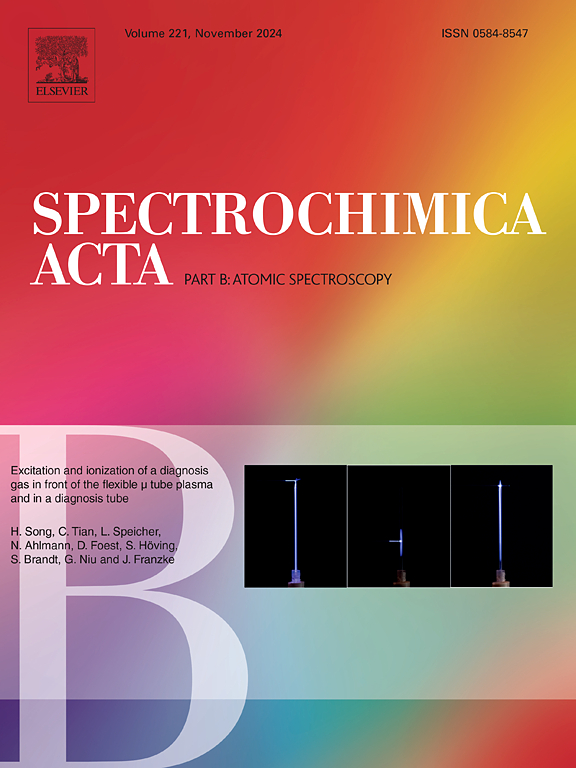氧化物颗粒密度对LIBS和LA-ICPMS激光取样的影响
IF 3.8
2区 化学
Q1 SPECTROSCOPY
引用次数: 0
摘要
本文采用激光诱导击穿光谱法(LIBS)和激光烧蚀电感耦合等离子体质谱法(LA-ICPMS)来评价烧结和样品密度对测量结果的影响。在不同温度下煅烧制备了两组质量密度不同的氧化锆球团。本研究的新颖之处在于确定了两种独立技术(LIBS和LA-ICPMS)的U-Zr氧化物颗粒密度对激光采样的影响。详细讨论了样品密度对优劣系数的影响。在还原气氛(Ar/H2)下的高温烧结增加了颗粒密度,提高了信号强度、相关系数(R2)、检测限、精度和LIBS的准确性。用1064 nm Nd:YAG激光对LA-ICPMS结果也有类似的影响,而用193 nm ArF准分子激光对LA-ICPMS结果的影响可以忽略。本文章由计算机程序翻译,如有差异,请以英文原文为准。

Effect of oxide pellet density on laser sampling for LIBS and LA-ICPMS
Laser-induced breakdown spectroscopy (LIBS) and laser ablation inductively coupled plasma mass spectrometry (LA-ICPMS) are employed in this article to evaluate the effect of sintering and sample density on the measurements. Two sets of U-Zr oxide pellets of different mass densities are prepared by calcination at two different temperatures. The novelty of the present study is to determine the effect of U-Zr oxide pellet density on laser sampling for two independent techniques (LIBS and LA-ICPMS). The impact of sample density on figure-of-merits is discussed in detail. Sintering at higher temperatures in a reducing atmosphere (Ar/H2) increases pellet density and improves signal intensity, correlation coefficient (R2), detection limit, precision, and accuracy for LIBS. A similar effect of pellet density is observed for LA-ICPMS result with 1064 nm Nd:YAG laser, whereas there is a negligible effect with 193 nm ArF excimer laser.
求助全文
通过发布文献求助,成功后即可免费获取论文全文。
去求助
来源期刊
CiteScore
6.10
自引率
12.10%
发文量
173
审稿时长
81 days
期刊介绍:
Spectrochimica Acta Part B: Atomic Spectroscopy, is intended for the rapid publication of both original work and reviews in the following fields:
Atomic Emission (AES), Atomic Absorption (AAS) and Atomic Fluorescence (AFS) spectroscopy;
Mass Spectrometry (MS) for inorganic analysis covering Spark Source (SS-MS), Inductively Coupled Plasma (ICP-MS), Glow Discharge (GD-MS), and Secondary Ion Mass Spectrometry (SIMS).
Laser induced atomic spectroscopy for inorganic analysis, including non-linear optical laser spectroscopy, covering Laser Enhanced Ionization (LEI), Laser Induced Fluorescence (LIF), Resonance Ionization Spectroscopy (RIS) and Resonance Ionization Mass Spectrometry (RIMS); Laser Induced Breakdown Spectroscopy (LIBS); Cavity Ringdown Spectroscopy (CRDS), Laser Ablation Inductively Coupled Plasma Atomic Emission Spectroscopy (LA-ICP-AES) and Laser Ablation Inductively Coupled Plasma Mass Spectrometry (LA-ICP-MS).
X-ray spectrometry, X-ray Optics and Microanalysis, including X-ray fluorescence spectrometry (XRF) and related techniques, in particular Total-reflection X-ray Fluorescence Spectrometry (TXRF), and Synchrotron Radiation-excited Total reflection XRF (SR-TXRF).
Manuscripts dealing with (i) fundamentals, (ii) methodology development, (iii)instrumentation, and (iv) applications, can be submitted for publication.

 求助内容:
求助内容: 应助结果提醒方式:
应助结果提醒方式:


